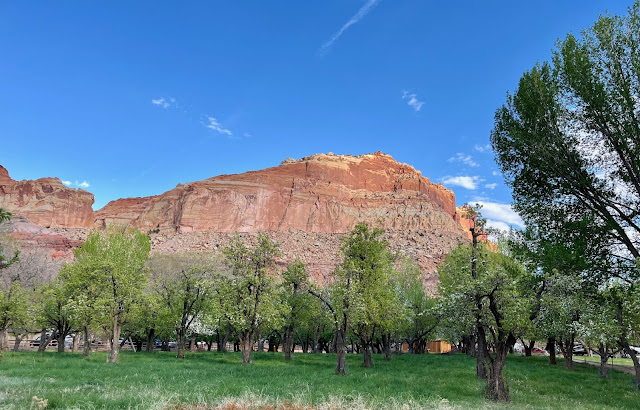Moominmama and the Waterpocket Fold
Wherein Moominmama learns about the Waterpocket Fold and explores a national park that nearly got named Wayne Wonderland...
It is almost impossible to convey the scale of Utah's cliffs and canyons in a photograph if you're not Ansel Adams. Instead, Moominmama asks you to scroll closely in the top photo where the sun hits the sand. There you will see two tiny figures hiking ahead of me, and maybe then you get a sense of the scale of just one canyon in the national park known as Capitol Reef.
The photo at right shows Fruita Valley, a desert oasis where the national park campground is located at the foot of the red cliffs and along a narrow river.
Having visited Zion and Bryce last year, I came across a reference to the Waterpocket Fold. Curious about this unusual geographic feature, Moominmama made a reservation this year in Capitol Reef to learn what this was and what it looks like. What I found in Capitol Reef was a little valley paradise without the crowds of the bigger parks. And I found a plethora of narrow and delightful canyons with features of both Arches and Zion national parks but with a much more intimate feel.
So what is the Waterpocket Fold, you ask? If you look at the cliffs above, you see the result of a fault line where part of the land lifted straight up (7,000 feet up) roughly 50 to 70 million years ago. While this mountain-building tectonic force impacted many areas on the Colorado Plateau, this one-mile stretch is unique because it slid forward (or folded) over the fault line, creating the valley but also buckling the land on the other side of the valley.
This meant travelers from the east came across a set of hills, entered a valley and confronted this wall of red rock on the western side. About 15 million years ago, a second uplift revealed even more rock layers. Weak spots along the one-mile sandstone edifice began washing away, causing rockfalls, creating canyons and carving the features that gave this area its name: waterpockets.
The basins, or tanks, provided a welcome source of water for wildlife during dry seasons, making this a hospitable place for a diversity of plants and creatures, including humans.
The first inhabitants date back to at least 300 C.E. and are believed to be the ancestors of the Hopi, Zuni and Paiute peoples. Europeans identify these people as the "Fremont culture," but native names for these same people translate to: People of Long Ago (Hopi) or People Who Lived the Old Ways (Paiute).
Whatever you call them, they left behind signs of irrigation, pottery, granaries, jewelry, baskets and petroglyphs. The soil, subject to periodic flooding, remained fertile, and animals were plentiful (and remain so, as deer and marmot continue to enjoy the valley). Around the year 1300, evidence of habitation wanes until early settlers arrived in the 1800s.
The Mormons would also flourish in this valley, planting fruit and nut trees that continue bear fruit to this day. This small Mormon village would farm and grow fruit to trade, teaching their children in a one-room schoolhouse until the advent of World War II.
One of the delights of the campground is the freedom to walk the orchards and, in season, pick some of the fruit. But the real draw for Moominmama was the canyons, each of them a little different from the last -- some with tall, cathedral-like walls, others textured and turned into strange sculptures. Some cozy, some immense.
Work to turn this area into a park began in the 1920s, when two nearby residents sought state and national recognition for a park they proposed to name Wayne Wonderland, which isn't quite as crazy as it sounds when you realize it's a reference to the county where Capitol Reef is located. When President Roosevelt finally made it a national monument in 1937, it instead carried the name Capitol Reef, a reference to a dome-like feature widely visible in the park and the cliffs that some likened to an ocean reef.
The name stuck (thank goodness) when President Nixon upgraded it to a national park in 1971, and it's one of the most delightful national parks Moominmama has visited to date.
One of the reasons for lower visitation may be the primitive nature of the campground, which has no showers. Much as Moominmama enjoyed her many hikes, she is glad to be back in civilization where she finally washed off the sweat of five days in the wilds!









Catching up with your travels and thoroughly enjoying your descriptions! Your visit to a place still “undiscovered” by the masses sounds wonderful! It is black fly season in New Hampshire and _ of course _ ticks abound so you may be glad to be in the desert air instead!
ReplyDeleteI would love to see canyons and deserts like this some day. I saw it a little in Canada and loved it. Having lived so long in NH, mountains and woods are what I know.
ReplyDelete